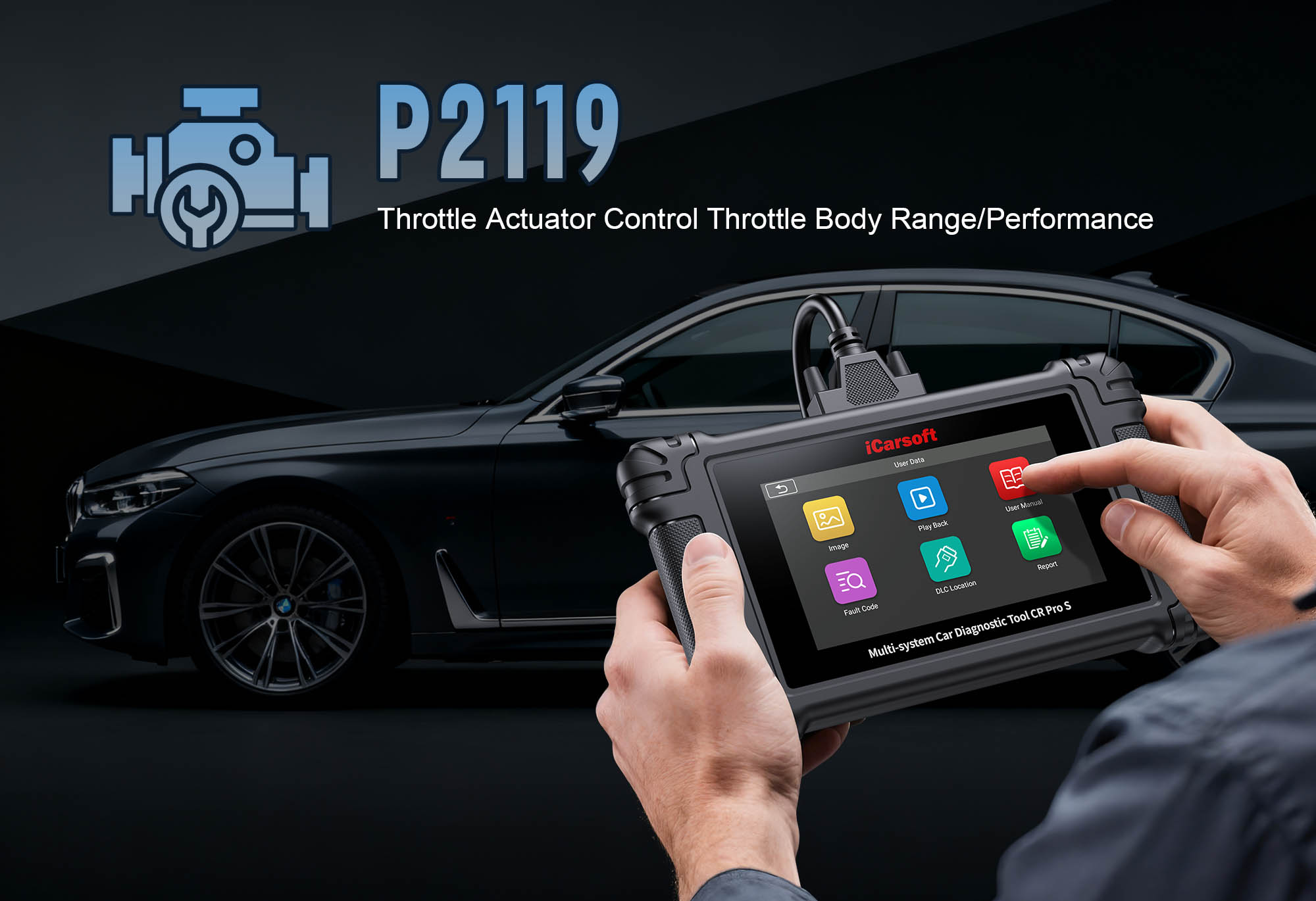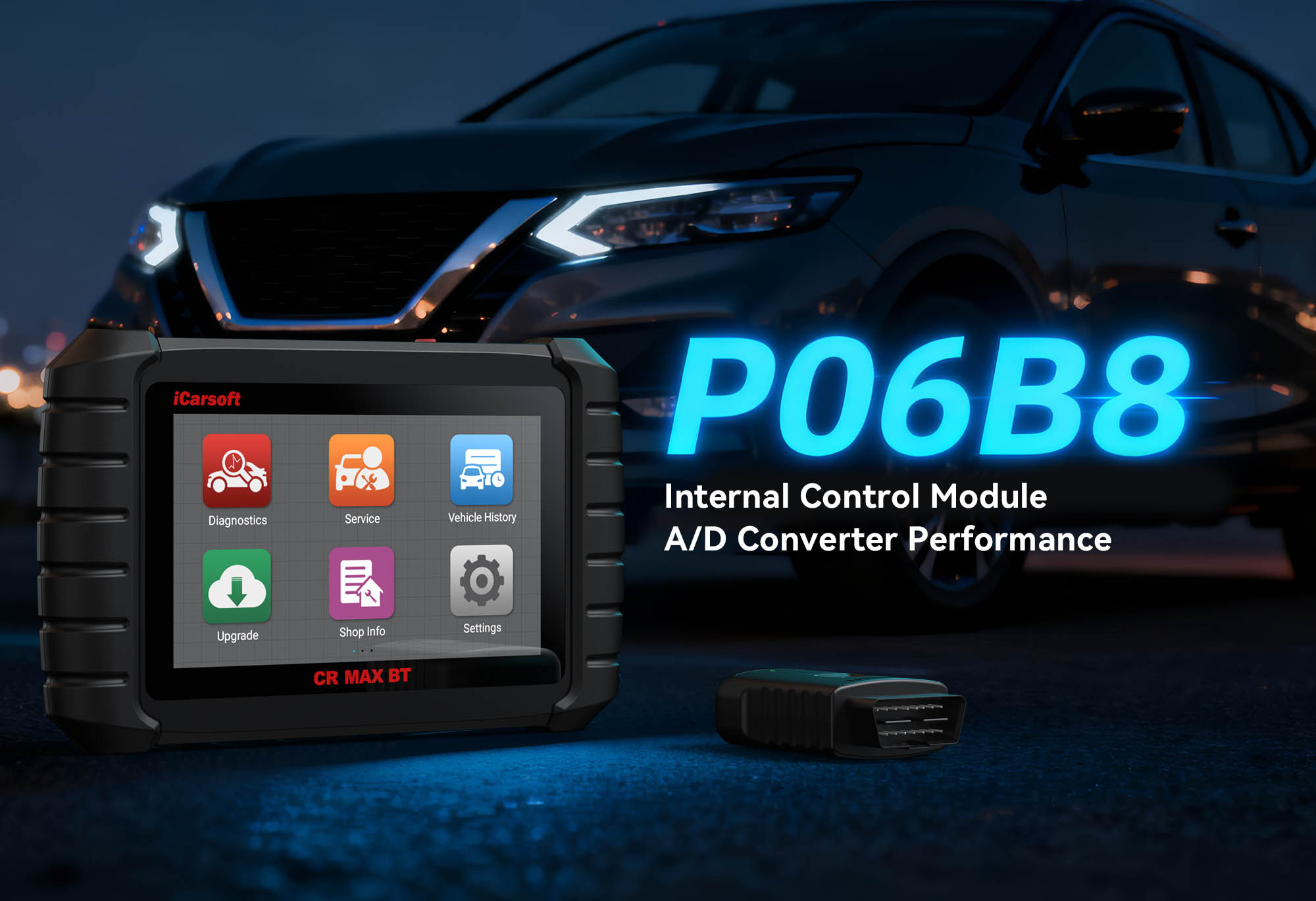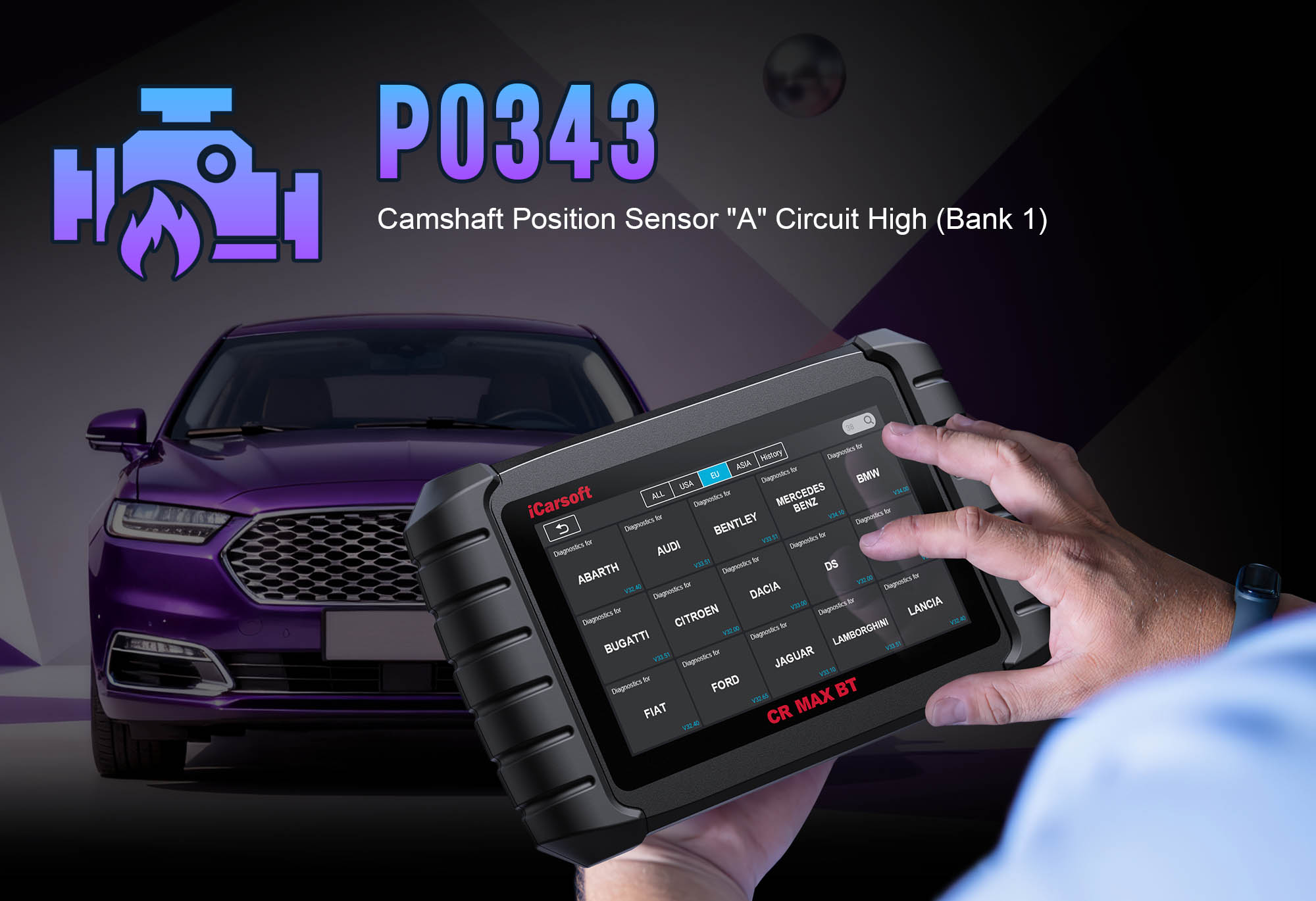Understand & Fix P2119: Throttle Actuator Control System - Throttle Body Range/Performance with iCarsoft CR Pro S
If your vehicle’s dashboard lights up with a "Check Engine" warning, you feel inconsistent acceleration, or it suddenly hesitates when pressing the gas pedal, a diagnostic scan will likely return P2119. This OBD-II code stands for "Throttle Actuator Control System - Throttle Body Range/Performance," targeting the electronic throttle control (ETC) system critical for modern drive-by-wire vehicles. Unlike traditional mechanical throttles, the ETC uses a motorized throttle body to regulate airflow—when the Engine Control Module (ECM) detects the throttle body’s movement or sensor signals are outside the normal range, it triggers P2119 to prevent engine damage.
Basic scanners might only label this a "throttle error" but can’t pinpoint whether the issue is a faulty throttle body, erratic sensor, or wiring glitch. This ambiguity leads to costly unnecessary part replacements. The iCarsoft CR Pro S cuts through guesswork with OE-level ETC diagnostics, bi-directional testing, and brand-specific data—ideal for resolving P2119 in Ford, Chevrolet, BMW, Toyota, and more. Below, we break down causes, symptoms, step-by-step fixes, and answers to common questions.
What Is P2119?
P2119 relates to the throttle body’s range or performance within the ETC system. The throttle body houses a motorized plate that controls airflow into the engine, paired with throttle position sensors (TPS) that send real-time data to the ECM. The ECM uses this data to adjust fuel injection and ignition timing. A "range/performance" error means the throttle plate isn’t moving as expected (sticking, slow movement) or the TPS sends erratic signals—both disrupting the air-fuel mixture and performance.
This code is common in high-mileage vehicles or those skipping throttle body maintenance, such as Chevrolet Silverado P2119, Toyota Tacoma throttle body malfunction, or BMW 5 Series ETC fault. Precise throttle control is critical for performance, making P2119 prevalent in luxury and utility models alike.
Key Symptoms of P2119
-
Inconsistent Acceleration: Surges or lags when pressing the gas pedal, especially at low speeds.
-
Illuminated Warning Lights: Check Engine Light (CEL) guaranteed, often paired with "Throttle Control" or "Engine Performance" messages.
-
Rough Idling: Engine shakes or fluctuates in RPM at stops, from unregulated airflow.
-
Reduced Power Mode: Mild power reduction (unlike P2110’s forced limp mode) to protect the engine.
-
Stalling: Severe cases may see the throttle plate stick closed, causing stalling at idle or slowdowns.
-
Poor Fuel Economy: Imbalanced air-fuel mixture leads to waste—common in Ford F-150 P2119 fuel efficiency issues.
Common Causes of P2119
|
Cause
|
Description
|
|
Dirty/Carbon-Clogged Throttle Body
|
Top cause (vehicles over 50k miles): Carbon buildup restricts throttle plate movement.
|
|
Faulty Throttle Position Sensor (TPS)
|
Integrated into the throttle body, sends erratic voltage—common in Honda Accord TPS malfunction P2119.
|
|
Worn Throttle Actuator Motor
|
Motor degrades over time, leading to slow or unresponsive throttle plate movement.
|
|
Wiring/Connector Issues
|
Frayed wires, corrosion, or loose terminals disrupt power/signals—prevalent in Jeep Wrangler P2119 wiring fault.
|
|
ECM Software Glitch
|
Outdated/corrupted software misinterprets data—triggers false codes in VW Golf ETC software issues.
|
|
Low Battery Voltage
|
Insufficient power to the actuator motor—common in older vehicles.
|
Why iCarsoft CR Pro S Excels at Diagnosing P2119
Resolving P2119 requires precise testing to avoid misdiagnosis. The CR Pro S stands out with ETC-tailored features:
Brand-Specific Code Decoding
Translates P2119 into model-specific insights (e.g., "Silverado: Throttle Plate Stuck at 10%"; "BMW: TPS Signal Out of Range").
Bi-Directional Throttle Testing
Sends open/close commands to the throttle plate—distinguishes faulty motor from dirty plate.
Live TPS & Throttle Data
Monitors TPS voltage (0.5V–4.5V) and plate angle in real time, highlighting P2119-triggering deviations.
Throttle Body Relearn
Calibrates new/cleaned throttle body to ECM (supports 56+ makes)—skipping this ensures P2119 returns.
Global Vehicle Coverage
Works with P2119-prone brands: Ford, Chevrolet, Toyota, Honda, BMW, Volkswagen, and more.
Built-In Multimeter
Tests wiring continuity/voltage—pinpoints corroded connector P2119 issues fast, no extra tools needed.
Step-by-Step: Diagnose & Fix P2119 with iCarsoft CR Pro S
-
Confirm P2119 & Gather Vehicle-Specific Data
Plug the CR Pro S into the OBD-II port, power on, and select AutoVIN Identify to detect make/model/ETC type.
Navigate to Engine > Fault Codes > Read Codes to confirm P2119. Tap Code Details for insights (e.g., "Toyota Tacoma: TPS Voltage 5.0V (Over Max); Check Throttle Body/Wiring").
-
Analyze Live ETC Data
Go to Engine > Live Data > Throttle Control to monitor three key metrics:
1. TPS Voltage: Rises smoothly 0.5V (idle)–4.5V (full throttle)—spikes/flatlines = TPS/wiring issue.
2. Throttle Plate Angle: Matches pedal input (0° idle, 90° full throttle)—mismatch = stuck plate/faulty actuator.
3. Battery Voltage: Ensure 12.4V–13.8V—low voltage (<12V) causes false P2119.
-
Test the Throttle Actuator & Sensor
1. Use Bi-Directional Control > Engine > Throttle Actuator Test: Send commands, listen for whirring, and check plate angle change. No response = faulty actuator/motor.
2. TPS Testing: Disconnect throttle body, use Resistance Test, and match to OEM specs (10–30 ohms)—open circuit = bad TPS.
-
Inspect & Clean/Replace Components
1. Clean Throttle Body: If actuator works but plate is stuck, remove and clean with throttle cleaner (fixes 60% of P2119 cases).
2. Check Wiring: Use Continuity Test for breaks between throttle body and ECM—repair/replace damaged wires.
3. Replace Faulty Parts: Install new throttle body/TPS if testing confirms defects (use OEM/quality aftermarket parts).
-
Relearn & Validate the Fix
- Run Throttle Body Relearn (under Special Functions) to sync with ECM—non-negotiable for lasting fixes.
- Use Engine > Fault Codes > Clear Codes to erase P2119.
- Test drive 50–100 miles, monitor live data—stable TPS voltage and smooth plate movement = issue resolved.
FAQs: P2119 Troubleshooting (Low-Competition Long-Tail Keywords)
Can I drive with P2119, or will it damage my engine?
Short trips (to a repair shop) are safe, but prolonged driving risks misfires, overheating, or stalling. Avoid towing with Chevrolet Silverado P2119—reduced airflow strains the engine. Diagnose immediately with the CR Pro S.
How much does it cost to fix P2119?
Costs vary: Throttle body cleaning + relearn = $80–$150 (DIY saves $100+). New throttle body = $150–$400 (parts + labor). TPS replacement = $100–$200. The CR Pro S avoids misdiagnosis, saving you from unnecessary $500+ ECM replacements.
Why does P2119 keep coming back after clearing the code?
Most often from skipping the throttle body relearn. Other culprits: partial cleaning (leftover carbon) or hidden wiring damage. Use the CR Pro S’s History Log to track recurrence—acceleration-related returns point to a failing actuator motor.
Is P2119 the same as P2110 or P2112?
No—P2119 = mild throttle body range/performance; P2110 = forced limp mode; P2112 = throttle plate stuck closed (severe). The CR Pro S clarifies differences, so you don’t mix up Ford F-150 P2119 vs. P2110.
Can I fix P2119 myself with the iCarsoft CR Pro S?
Absolutely—if the issue is a dirty throttle body or faulty TPS. The CR Pro S’s component location tool and guided tests make DIY P2119 repair Honda Civic accessible even for beginners.
Will a throttle body cleaner fix P2119?
Often yes—if carbon buildup is the root cause. Use electronic throttle-specific cleaner (not carburetor cleaner) for Toyota Tacoma P2119, and follow with a CR Pro S relearn to lock in the fix.
Does low battery voltage cause P2119?
Yes—insufficient power disrupts the actuator motor. Test voltage with the CR Pro S’s multimeter, especially for older Ford P2119 low voltage issues. A charge or replacement may resolve the code.
How do I prevent P2119 from happening again?
Clean the throttle body every 30k–50k miles and use high-quality fuel. For BMW 5 Series P2119 prevention, avoid short trips (cause incomplete combustion/carbon buildup). Run monthly ETC checks with the CR Pro S to catch issues early.
Conclusion
P2119’s inconsistent performance and warning lights are frustrating, but the iCarsoft CR Pro S turns guesswork into precise diagnosis. Whether it’s a dirty throttle body in a Ford F-150, faulty TPS in a Honda Accord, or wiring issue in a Chevrolet Silverado, this tool delivers brand-specific data and testing to fix P2119 quickly and affordably.
With a 5-inch touchscreen, lifetime free software updates, and support for 50+ brands, the CR Pro S is essential for DIYers and mechanics. Don’t let P2119 disrupt your drive—use the CR Pro S to resolve throttle control issues and restore your vehicle’s performance.





